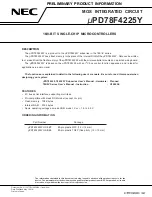Chapter 3 Modes of Operation
MC9S08QL8 MCU Series Reference Manual, Rev. 1
NXP Semiconductors
29
3.6.1
Stop2 Mode
Stop2 mode is entered by executing a STOP instruction under the conditions as shown in
. Most
of the internal circuitry of the MCU is powered off in stop2 with the exception of the RAM and optionally
the RTC and low power oscillator. Upon entering stop2, all I/O pin control signals are latched so that the
pins retain their states during stop2.
Exit from stop2 is performed by asserting the wakeup pin (PTA5/IRQ/TCLK/RESET) on the MCU.
NOTE
PTA5/IRQ/TCLK/RESET is an active low wakeup. To avoid an immediate
exit from stop 2, either the internal pullup must be enabled prior to
executing a STOP instruction or an external pullup must be connected. If
PTA5/IRQ/TCLK/RESET is not to be used as the wakeup pin, configure it
as PTA5 with the pullup enabled.
In addition, the real-time counter (RTC) can wake the MCU from stop2, if enabled.
Upon wakeup from stop2 mode, the MCU starts up as from a power-on reset (POR):
•
All module control and status registers are reset, except for SPMSC1-SPMSC3, RTCSC, RTCCNT
and RTCMOD.
•
The LVD reset function is enabled and the MCU remains in the reset state if V
DD
is below the LVD
trip point
•
The CPU takes the reset vector
In addition to the above, upon waking from stop2, the PPDF bit in SPMSC2 is set. This flag is used to
direct user code to go to a stop2 recovery routine. PPDF remains set and the I/O pin states remain latched
until a 1 is written to PPDACK in SPMSC2.
If using the low power oscillator during stop2, the user must reconfigure the ICSC2 register which contains
oscillator control bits before PPDACK is written.
To maintain I/O states for pins that were configured as GPIO before entering stop2, the user must restore
the contents of the I/O port registers, which have been saved in RAM, to the port registers before writing
to the PPDACK bit. If the port registers are not restored from RAM before writing to PPDACK, then the
pins will switch to their reset states when PPDACK is written.
For pins that were configured as peripheral I/O, the user must reconfigure the peripheral module that
interfaces to the pin before writing to the PPDACK bit. If the peripheral module is not enabled before
writing to PPDACK, the pins will be controlled by their associated port control registers when the I/O
latches are opened.
3.6.1.1
Stop2 Mode Recovery Time
The stop2 recovery time is defined as the interval from the exit trigger to the first opcode fetch. There are
three main components to this wakeup time: the voltage regulator recovery time, the clock source start up
time, and the reset processing time.
Содержание MC9S08QL4
Страница 4: ...MC9S08QL8 MCU Series Reference Manual Rev 1 4 NXP Semiconductors...
Страница 24: ...Chapter 2 Pins and Connections MC9S08QL8 MCU Series Reference Manual Rev 1 24 NXP Semiconductors...
Страница 36: ...Chapter 3 Modes of Operation MC9S08QL8 MCU Series Reference Manual Rev 1 36 NXP Semiconductors...
Страница 56: ...Chapter 4 Memory MC9S08QL8 MCU Series Reference Manual Rev 1 56 NXP Semiconductors...
Страница 120: ...Analog Comparator S08ACMPVLPV1 MC9S08QL8 MCU Series Reference Manual Rev 1 120 NXP Semiconductors...
Страница 148: ...Analog to Digital Converter S08ADC12V1 MC9S08QL8 MCU Series Reference Manual Rev 1 148 NXP Semiconductors...
Страница 162: ...Internal Clock Source S08ICSV3 MC9S08QL8 MCU Series Reference Manual Rev 0 162 NXP Semiconductors...
Страница 172: ...Modulo Timer S08MTIMV1 MC9S08QL8 MCU Series Reference Manual Rev 1 172 NXP Semiconductors...
Страница 200: ...Serial Communications Interface S08SCIV4 MC9S08QL8 MCU Series Reference Manual Rev 1 200 NXP Semiconductors...
Страница 224: ...Timer Pulse Width Modulator S08TPMV3 MC9S08QL8 MCU Series Reference Manual Rev 1 224 NXP Semiconductors...
Страница 238: ...Development Support MC9S08QL8 MCU Series Reference Manual Rev 1 238 NXP Semiconductors...
Страница 239: ......


















